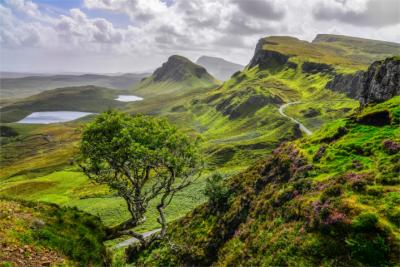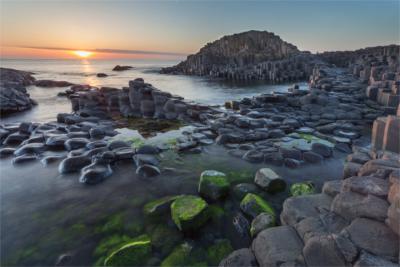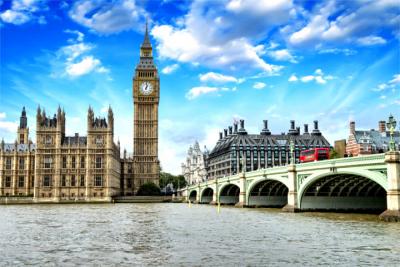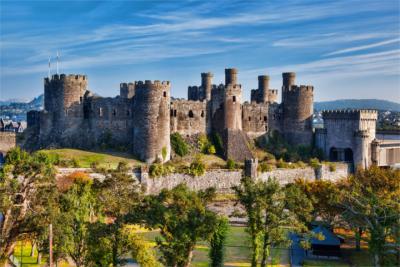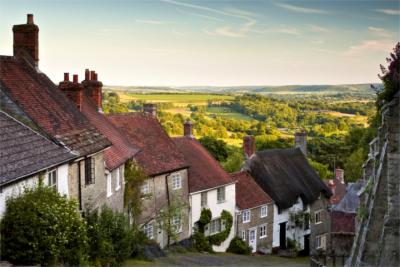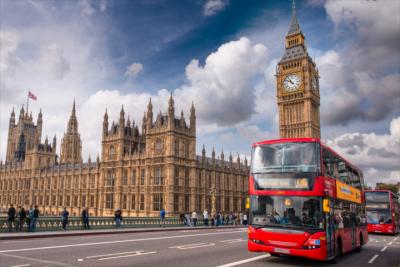Travel Offers
Travelmyne Featureprint
Distance
United Kingdom - Europe's Royal Island
The legacy of the Celts and Vikings, the legends of King Arthur in Camelot and the culture of the highlanders in Scotland - this many impressions call for a relaxing teatime in London, the heart of the greatest European island state in the United Kingdom.

Geography - England, Scotland, Wales and Northern Ireland
The former independent countries Northern Ireland, Wales, Scotland and England constitute the union of the "United Kingdom of Great Britain and Northern Ireland" today. In addition, several independent territories like the Shetland Islands, Bermuda, Montserrat or Gibraltar belong to the state. Great Britain is the greatest European island state and, just like Ireland and Northern Ireland, it is located in front of the north-west coast of continental Europe in the North Sea and the Atlantic Ocean. About 1,000 smaller islands are grouped around the main island. The Inner and Outer Hebrides in front of Scotland's coast are popular travel destinations. Great Britain offers a wide variety of landscapes which are worth seeing. In Wales, the smallest part of the island state, the Cambrian Mountains dominate the region's panorama. Vast green meadows alternate with hilly mountain landscapes. Their highest mountain Snowdon is 1,085 metres high. The highest mountain in the whole of the United Kingdom is Ben Nevis in Scotland. Is has a height of 1,344 metres and is very popular with tourists and locals. The island state's climate is temperate throughout the year. Temperatures can increase in summer but Great Britain is generally not blessed with many hours of sunshine. High precipitation and weather which changes from day to day dominate the climatic conditions. The south is generally somewhat warmer than the north of the island. The region around Cornwall forms a climatic exception. Its proximity to the warm Gulf Stream causes a Mediterranean climate and atmosphere, even palms flourish along the southern British beaches.

Nature - Moorland, Highlands and the willow ptarmigan
Vast moorland in an eerily beautiful mountain landscape creates England's typical British charm. The Scottish Highlands and the lakes of Fermanagh or the Sperrin Mountains in Northern Ireland are very appealing and worth a visit. The British island is populated by different species of deer and by the mink. You can often watch grey seals and harbour seals in the coastal regions. Scotland is home to the Atlantic puffin and the Scottish willow ptarmigan. There are a good dozen of nature and national parks in Great Britain, especially the Center Parcs are popular with visitors. In Wales the Snowdonia National Park, the Brecon Beacons National Park and the Pembrokeshire Coast National Park are worth seeing. Another impressive attraction are the varied parts of the coast around the island state. Harsh steep coasts, scenic chalk cliffs or white sandy beaches offer various opportunities for experience and enjoyment on over 1,200 kilometres altogether. The flora and fauna is particularly distinct in the extensive Lake District in England. A number of endangered animal species like the moraine and the char live here. On shore you can watch red deer.

Natural sights - The Highlands and Giant's Causeway
You find the most beautiful strips of land of the United Kingdom in Scotland and Northern Ireland. The impressive island chain of the Hebrides in the Atlantic measures over 240 kilometres and can easily be explored by ship. The mystic Scottish Highlands contain a sight which has been attracting whole busloads of onlookers and adventurers for decades: Loch Ness and its inhabitant Nessie. There is no solid evidence for the existence of the lake monster but strange observations, which stimulate people's phantasy, are made again and again. Another Scottish Lake, Loch Lomond, fascinates with its fjord-like beauty. It is located in the Trossachs, a region in which the plane land meets the western plateau. The most distinctive Northern Irish formation is the Giant's Causeway, which counts over 37,000 prismatic basalt columns - a freak of nature like no other. The Lake District in Cumbria contains England's greatest natural lake Windermere, which extends over 17 kilometres and is up to 65 metres deep. At the west coast you find one of the island's most beautiful lake resorts - Blackpool. Tourists enjoy the historical double-decker tram which runs along the promenade or climb the Blackpool Tower - an exact but smaller copy of the Eiffel Tower. You get higher up by walking the Mountain Track on Ben Nevis, which is seven kilometres long and gives small and grown-up mountaineers the opportunity to get to know Britain's highest mountain at close range. The legendary Sherwood Forest in Nottinghamshire is a destination for children and families. It owes its fame to the stories about the hero Robin Hood. Today, its main attraction are the forest's age-old oak trees. The biggest one among them is called "Major Oak" and is said to have survived thousands of years. Its heavy branches can only be kept upright by an elaborate support construction. According to legend, the proud oak already sheltered Robin Hood from his enemies. A recent natural project, which was started in 2001, bears the biblical name "Eden Project". These futuristic-looking domed structures in the middle of the landscape of Cornwall comprise an area of over 50 hectares and are an environmental project which is unique worldwide. Over 5,000 types of plants, including a number of endangered species, are grown there under tropical and subtropical conditions. At the south coast you also find the so-called "Seven Sisters" of East Sussex. This impressive chain of white chalk cliffs is located between the towns Eastbourne and Seaford and presents another extraordinary facet of the island state.

Culture - From King Arthur to the Queen
The ancient Romans first discovered the remote island and ruled it for 350 years until the Angles and Saxons took over. The indigenous Celts were largely expelled by the latter but their customs and traditions have remained to the present day. Great Britain's culture is mainly characterised by the Middle Ages. Old legends of King Arthur and his noble knights, Camelot and the myth-enshrowded sword Excalibur still dominate the image the world has of the old England. In the modern period of the 19th century the United Kingdom had already become the greatest industrial and seafaring nation worldwide and was considered the pioneer of colonisation. The British Empire neared its peak. Today the state is the third most populous European country and is characterised by the monarchical mind of Queen Elisabeth II. Many of the most significant architectural accomplishments can be found in London. The Palace of Westminster, the Tower Bridge and the Big Ben are some of the most popular tourist attractions. Travellers always notice the dry or black humour as it was spread by typical British series like Mr. Bean. The Englishman is regarded as reserved, polite, patient and obliging - the perfect gentleman. This conservative image, however, changes at nightfall. The islanders prove to be hard-drinking and entertaining, especially in the typical pubs. Besides their odd sense of humour, the Britons are also considered to have a certain propensity for eccentricity and a marked national pride. Despite the sulky weather, the inhabitants are very hospitable towards visitors.

Cultural sights - Masterly architecture has tradition
Stonehenge is one of the United Kingdom's most frequently photographed cultural sights. The mystery of its origin and meaning make this World Heritage site so appealing and exciting. It was erected over 4,000 years ago but who did it can still not be determined with absolute certainty. The greatest and most beautiful British castles and cathedrals in Gothic and Romanesque style were built much later. Windsor Castle in Berkshire is the oldest castle and ideally suited as the Queen's residence with its 1,000 rooms. Some of the most impressive sacred buildings are the Winchester Cathedral in Hampshire and the Canterbury Cathedral in Kent. The cultural centre is of course the capital London. The British Museum, Hampton Court maze, the scenic Hyde Park as well as the coronation cathedral Westminster Abbey and the crown jewels in the Tower of London are all worth a visit. You should also not miss out on the London Zoo and St. Paul's Cathedral. Travellers who want to see the oldest universities should go to Oxford and Cambridge, especially their gigantic libraries are a must. Of course, you also find numerous castles and ruins in Scotland, several hundreds are located in the Grampian Mountains alone. The Scottish city Edinburgh needs to be mentioned as a cultural centre of the island. Dozens of museums, performances and festivals attract countless visitors to the second biggest Scottish city every year. The Iron Bridge in the town of the same name (Ironbridge) opened in 1779 and was the world's first iron bridge. It became part of the UNESCO World Cultural Heritage in 1986 and has been a real crowd puller ever since, which pleases the town and the adjacent teddy bear factory. The great English gardens also came into fashion in the 18th century. They were meant to form a contrast to the French baroque gardens, which were prevalent at that time, and be places were people can enjoy quiet and relaxation. You find the most beautiful and masterly green spaces in Bath or Hestercombe in Somerset, for example, which are venues for many cultural events.

Experience - Individual with regard to its cuisine, excellently suited as a shopping metropolis
The British cuisine is a rather controversial topic. Odd combinations and unusual ingredients are not to everyone's liking. The ever-present fish and chips were originally served wrapped in yesterday's newspaper. People only had the traditional Sunday roast, consisting of a piece of meat and two vegetable sides, which is served with Yorkshire pudding, on Sunday. The Briton's national drink is and will remain the tea. The teatime also finds favour with tourists. Another typically British speciality is the English breakfast, which consists of several courses and contains both savoury and sweet components. First you have a fresh juice or a grapefruit and eat cereal in the form of cornflakes, oats or porridge. Savoury sausages, bacon, scrambled and fried eggs as well as fried tomatoes and button mushrooms constitute the main course. The Britons actually adopted and integrated baked beans, which are associated with the United Kingdom today, from the Americans. You end your breakfast with a slice of toast with lime or orange marmalade. The Scottish cuisine has produced its own creations, which differ considerably from English food. Haggis - the national dish - is a sheep's stomach stuffed with pluck, which is cooked, cut in halves and served for lunch. The desserts scones and crumpets are better suited for the international taste, at least to start with. A Scottish culinary highlight is their whisky, also called "scotch". Matured in oak-casks for years, the spirit came to global fame. Visitors can experience the Scottish lifestyle culture first-hand on an original whisky trail through the country's most beautiful distilleries. Those interested in a city trip are in good hands in London. Window-shopping in Fortnum & Mason in Picadilly or a shopping tour through the world-famous department store Harrods make many visitors' hearts leap for joy. A visit to Madame Tussauds or a tour through the lively West End of London with its centre Picadilly Circus round off a city trip through London. The many theatre and musical performances in the West End provide evening entertainment. Andrew Lloyd Webber made musical history with works like Cats or The Phantom of the Opera and popularised not only the genre but also England with regard to this cultural branch. The British nightlife impresses with party locations and music trends. Besides London, Newcastle or the seaport city Blackpool are famous party centres. Furthermore, Great Britain does not lack leisure and amusement parks either. A classic among them is the English leisure park Alton Towers. The park World of Adventure in Chessington is a combination of amusement park and zoo, and Thorpe Park in the county of Surrey offers spectacular roller coasters at world record level. The amusement park Drayton Manor near Birmingham or the Legoland Windsor west of London are best suited for children and families.

Activities - Hiking, cycling and enjoying
Visitors of London get a first overview of the city on a ride on the London Eye, the highest big wheel in Europe. Looking at the city from above, the Big Ben and the Westminster Bridge over the Thames do not seem far away. Travellers can also be active in the United Kingdom. How about a hike through the scenic landscape in the Lake District in Lancashire or a cycling tour along the Great Glen Way in Scotland from the west into the Highlands? Hillwalkers also get their money's worth in Scotland. Those who manage to climb all 284 hills and mountains of the Munros can proudly call themselves "munroists". Furthermore, England and Scotland are golf nations. Some inhabitants even claim that the sport was invented here. At the right time of the year, the south coast regions around Bournemouth offer great conditions for beach holidays. Divers and water sports fans can pursue their hobbies in the Lake District and the sea which surrounds the island.

Information
Thanks to the Channel Tunnel, European visitors can reach Great Britain by bus, train or car. If you are driving your own car, please mind the left-hand traffic on the British island. The biggest airports are Heathrow and Gatwick in London or Manchester Airport. Since the weather is changeable throughout the year, an umbrella should be part of every traveller's hand luggage.
London, Edinburgh and Glasgow are the perfect destinations for a city trip as shopping and sightseeing feature prominently here. The Scottish Highlands are the place to be for landscape experts and the island is generally characterised by the atmosphere of monarchy.

